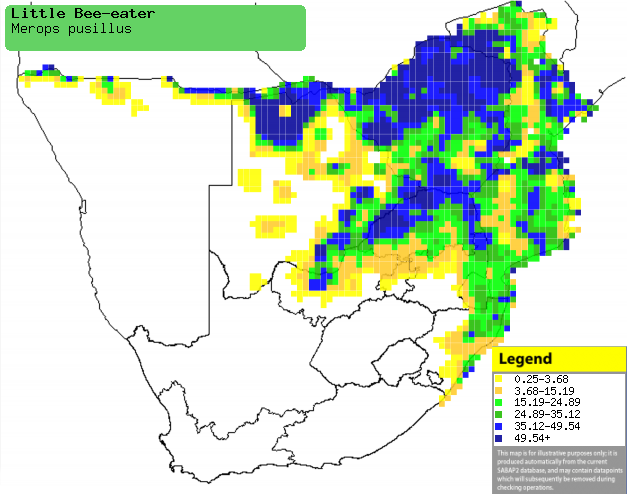|
Merops pusillus (Little
bee-eater)
Kleinbyvreter [Afrikaans]; iNkotha (also applied to
Woodland kingfisher) [Zulu]; Tinziwolana (generic term for bee-eater) [Tsonga];
Morôkapula (generic term for bee-eater) [Tswana]; Dwergbijeneter [Dutch];
Guępier nain [French]; Zwergspint, Zwergbienenfresser [German];
Abelharuco-dourado [Portuguese]
Life
> Eukaryotes >
Opisthokonta
> Metazoa (animals) >
Bilateria >
Deuterostomia > Chordata >
Craniata > Vertebrata (vertebrates) > Gnathostomata (jawed
vertebrates) > Teleostomi (teleost fish) > Osteichthyes (bony fish) > Class:
Sarcopterygii (lobe-finned
fish) > Stegocephalia (terrestrial
vertebrates) > Tetrapoda
(four-legged vertebrates) > Reptiliomorpha > Amniota >
Reptilia (reptiles) >
Romeriida > Diapsida > Archosauromorpha > Archosauria >
Dinosauria
(dinosaurs) > Saurischia > Theropoda (bipedal predatory dinosaurs) >
Coelurosauria > Maniraptora > Aves
(birds) > Order: Coraciiformes
> Family: Meropidae
The Little bee-eater is probably the most common bee-eater in
Africa, with an estimated population of 60-86 birds! It occurs everywhere in
sub-Saharan Africa except the Lowland forest areas of West Africa, and the
western half of southern Africa, where it mainly lives in savanna. It feeds
mostly on bees, as well as dragonflies, wasps etc. Both sexes excavate the nest,
which consists of a long tunnel, ending in an egg chamber, dug into riverbanks
or ditches. It lays 2-6 eggs, which are incubated by both sexes, for 18-20 days.
The chicks stay in the nest for 23-24 days, after which they are dependent on
their parents for several weeks more.
Distribution and habitat
Probably the most common bee-eater in Africa, with an
estimated population of 60-86 million birds! It occurs across sub-Saharan
Africa; in southern Africa it is common in northern Namibia, Botswana, Zimbabwe,
Mozambique and
north-eastern South Africa. It generally prefers dry and moist savanna, partly
dry marshes, lake shores, riverbanks, farmland and grassy clearings
in forests.
|
 |
|
Distribution of Little bee-eater in southern
Africa, based on statistical smoothing of the records from first SA Bird
Atlas Project (©
Animal Demography unit, University of
Cape Town; smoothing by Birgit Erni and Francesca Little). Colours range
from dark blue (most common) through to yellow (least common).
See here for the latest distribution
from the SABAP2. |
Brood parasites
It has been recorded as host of the
Greater honeyguide and
Lesser honeyguide.
Food
It exclusively eats insects, doing most of its hunting from low perches, hawking insects aerially
before returning to the perch to beat them to death. The following insects have
been recorded in its diet:
Breeding
- Both sexes excavate the nest, which consists of a 0.5-1.3 m long tunnel,
ending in a 10 cm wide egg chamber. It is usually dug into high, sandy banks
such as riverbanks, ditches or plough furrows.
- Egg-laying season is from August-February, peaking from
September-December.
- It lays 2-6 eggs, which are incubated by both sexes for about 18-20 days.
- The chicks stay in the nest for 23-24 days, becoming fully independent
several weeks later.
Threats
Not threatened.
References
-
Hockey PAR, Dean WRJ and Ryan PG (eds) 2005. Roberts
- Birds of southern Africa, VIIth ed. The Trustees of the John Voelcker
Bird Book Fund, Cape Town.
|
